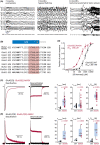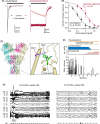A gain-of-function GRIA2 variant associated with neurodevelopmental delay and seizures: Functional characterization and targeted treatment
- PMID: 36161652
- PMCID: PMC10092096
- DOI: 10.1111/epi.17419
A gain-of-function GRIA2 variant associated with neurodevelopmental delay and seizures: Functional characterization and targeted treatment
Abstract
α-Amino-3-hydroxy-5-methyl-4-isoxazolepropionic acid-type glutamate receptors (AMPARs) are ligand-gated cationic channels formed from combinations of GluA1-4 subunits. Pathogenic variants of GRIA1-4 have been described in patients with developmental delay, intellectual disability, autism spectrum disorder, and seizures, with GRIA2 variants typically causing AMPAR loss of function. Here, we identify a novel, heterozygous de novo pathogenic missense mutation in GRIA2 (c.1928 C>T, p.A643V, NM_001083619.1) in a 1-year-old boy with epilepsy, developmental delay, and failure to thrive. We made patch-clamp recordings to compare the functional and pharmacological properties of variant and wild-type receptors expressed in HEK293 cells, with and without the transmembrane AMPAR regulatory protein γ2. This showed GluA2 A643V-containing AMPARs to exhibit a novel gain of function, with greatly slowed deactivation, markedly reduced desensitization, and increased glutamate sensitivity. Perampanel, an antiseizure AMPAR negative allosteric modulator, was able to fully block GluA2 A643V/γ2 currents, suggesting potential therapeutic efficacy. The subsequent introduction of perampanel to the patient's treatment regimen was associated with a marked reduction in seizure burden, a resolution of failure to thrive, and clear developmental gains. Our study reveals that GRIA2 disorder can be caused by a gain-of-function variant, and both predicts and suggests the therapeutic efficacy of perampanel. Perampanel may prove beneficial for patients with other gain-of-function GRIA variants.
Keywords: AMPA receptor; GRIA disorder; GluA2; epilepsy; perampanel.
© 2022 The Authors. Epilepsia published by Wiley Periodicals LLC on behalf of International League Against Epilepsy.
Conflict of interest statement
None of the authors has any conflict of interest to disclose.
Figures


References
-
- Schwenk J, Baehrens D, Haupt A, Bildl W, Boudkkazi S, Roeper J, et al. Regional diversity and developmental dynamics of the AMPA‐receptor proteome in the mammalian brain. Neuron. 2014;84:41–54. - PubMed

